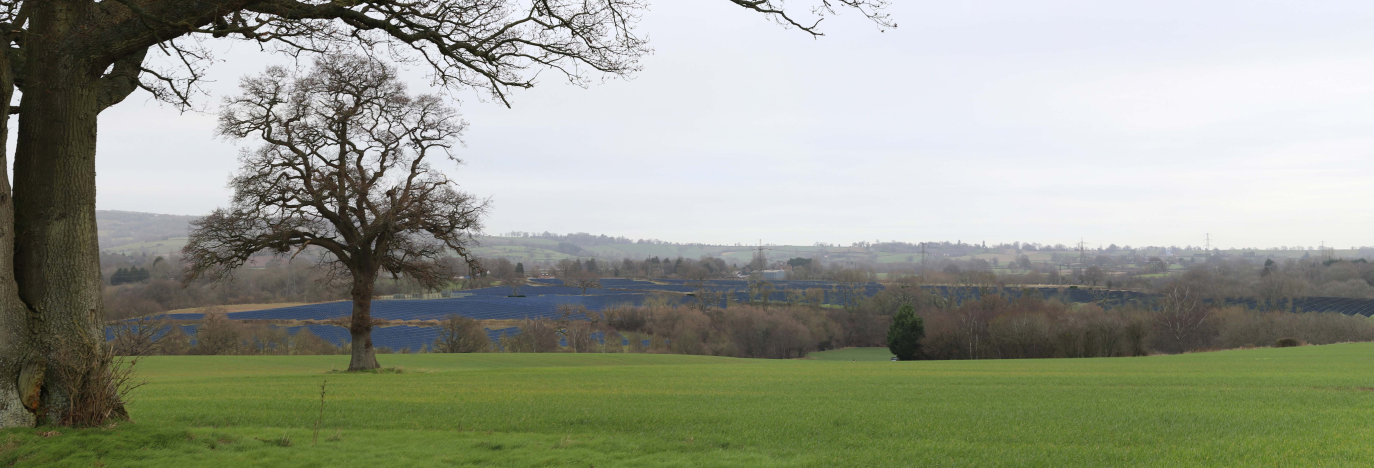There is a feeling that it is a new gold rush. In reality the current suite of planning applications for solar farms east and south east of Ludlow is being driven by farmers seeking a more secure income in turbulent times, the pressing need to reduce CO2 emission from electricity generation as part of the UK’s net zero commitment and the opportunities for to connect solar farms to the national grid.
There is currently one solar farm east of Ludlow suppling the national grid. Another four are at different stages of the planning system. They may not be the last applications we will see in this area.
Why so many in this area? The straightforward answer is that there is capacity to connect to the national power grid through Squirrel Lane Substation.
We have one solar farm in operation on the outskirts of Ludlow at Henley Hall. Planning applications have been submitted for solar farms at Ledwyche and Brick House Farm (Greete). Applications for two more at Rock Farm (Rocks Green) and Pervin Farm (Caynham) are in the pipeline. Other farmers and landowners are understood to be looking at the potential for solar farms on land near Ludlow.
In common with most substations, lines of different voltages radiate out from Squirrel Lane. The map above shows how the five main solar farms (one installed, four planned) cluster close to the substation or to the main power lines. (Bromfield Solar Farm is not connected to the grid and supplies the nearby quarry.)
New solar farms no longer receive a subsidy from the government. That has led to proposals for larger installations. The price of connection to the grid rises the further the site is from the substation or an overhead line in close proximity to a substation. Transmission losses also rise with distance. That’s why we have a cluster of solar farms along Squirrel Lane.
When Logogen, which has applied to build the Ledwyche Solar Farm, was searching for a suitable site in the area it identified a 5km search area around the substation, with priority given to areas within 1km of an overhead line or 2km of the substation.
The planned solar farms will not require any additional overhead lines, with any connections being undergrounded or a lattice tower.
There are a number of reasons why solar farms are attractive to farmers and landowners. The price of agricultural land is currently high as are electricity prices. The cost of installing solar farms has also fallen dramatically, by around 80% since 2010.
Farming incomes are often uncertain and at the moment they are more so. The government is phasing out the Basic Payment Scheme (BPS) which provided landowners with an income based on the area farmed. While BPS payments are being cut now, the replacement Environmental Management Scheme (ELMS) is only just beginning and is expected to disadvantage smaller farms. Fertiliser costs have rocketed in recent months, as of course have fuel costs. Because of these costs, farm gate prices are also rising but pressure from the major retailers to keep prices down mean that margins are squeezed.
Solar farms provide a secure income. Leasing land for a solar farm can bring in an annual between £350 to £450 per hectare for 40 years with potential for a share of the income from power generation. While farmer might retain responsibility for hedgerow management and grazing below the panels, costs will be reduced, often along with a reduced need for workers at a time of labour shortages.
The current proposals will take up all capacity at the Squirrel Lane substation, though I am uncertain if there is sufficient capacity for Pervin Solar farm. However, WPD is implementing an Active Network Management System, which is expected to better manage supply and demand and could free up further capacity for connections.
Another way of balancing supply demand is through battery storage units. There is already a 20MW installation on Rock Farm and we can expect more battery units to be installed as the number of solar farms in the area grows.
It is possible that we will get further applications for solar farms.




I’m not against them as such but considering a large area of land around the eco park is being covered with new houses and industrial units why can’t they be built with panels on the roofs?
I realise that housing won’t be able to be built with such a high density of panels but it’s otherwise dead space .